Briefly: In our opinion, short (full) speculative positions in gold, silver and mining stocks are justified from the risk/reward point of view.
Gold moved decisively higher this week, but we can’t say the same about other key parts of the precious metals sector: silver and mining stocks. Which part of the precious metals sector is showing the real direction in which the sector will head next?
The other – and more useful in this case – way to ask the above question is: “Which part of the precious metals sector is signaling the change in the trend?” In our opinion, there are no such signals. Let’s keep in mind that gold is often viewed as a hedge against uncertainties and the same does generally not apply to other parts of the precious metals sector. Silver and miners are highly correlated with gold, but during increased geopolitical tensions, it is gold that gains the most. What’s another asset that is viewed as a safe harbor in times of distress? Well, we don’t really view it as such, but the market views the US dollar as a safe haven as well.
Now, taking the above into account along with what has happened recently (plunging stocks in China and escalating tensions in the Middle East), it’s no wonder that both gold and the USD Index rallied, while the rest of the precious metals market is not doing as much. Does this indicate a change in the trend? No. It’s a reaction to events that are not that predictable (moves in stocks could have been predicted, but their daily volatility and the decision to close the exchange is something different). Furthermore, it doesn’t seem that these events will have a long-lasting impact despite the fact that they may seem critical at this time (remember when Russia took Crimea from Ukraine? In our opinion that was a much more critical geopolitical event and… Gold has declined about $200 since then).
So, what are the implications of the move higher in gold? That gold moved temporarily higher and… Well, that’s it. It doesn’t imply a continuation of the rally. When it “turns out” that actually little has changed (and that the multiple bearish factors listed in Monday’s alert remain in place), gold will likely give away the gains that we’ve seen recently, and thus we are not changing our downside targets. Overall, we think the rally in gold changed little. Let’s examine the situation from the technical perspective (charts courtesy of http://stockcharts.com).
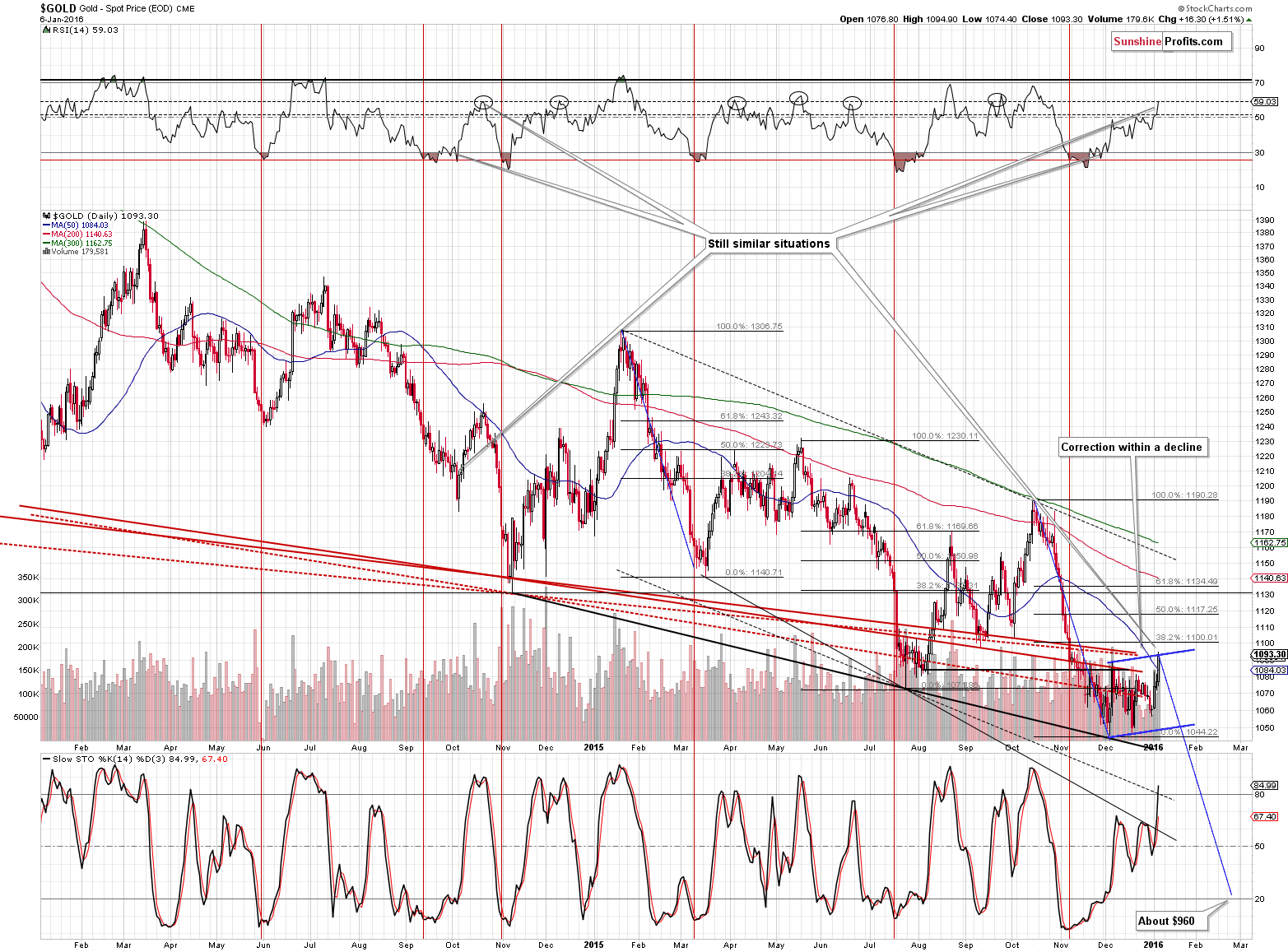
Gold’s move higher didn’t take it above the consolidation pattern – gold remains in the flag pattern and these patterns are usually followed by a move similar to the one precedes them. Consequently, the implication is that gold is still likely to move to about $960-$970 or so before forming another local bottom.
Now, $1,100 is a round number and a 38.2% Fibonacci retracement level, so we still can’t rule out a move to this level, or even to the 50% retracement – on a temporary basis. Such a move would not change much from the medium-term perspective.
Let’s consider the similarities – for several weeks the above chart has been featuring the similarity between the December 2015 bottom and the October 2014 bottom. Continuing with this analogy, we see that gold moved close to its 50-day moving average and even a bit above it and the RSI indicator moved very close to the 60 level. Back in 2014 these circumstances meant that a local top was in. In fact, in many other cases (we marked these situations with ellipses on the RSI indicator) gold ended local rallies when the RSI approached the 60 level. The implications are bearish.
One more thing – technically, until gold moves above $1,135 or so – the 61.8% Fibonacci retracement level – the rally will likely be just a rebound after the October 2015 – December 2015 decline. Consequently, moving above $1,100 or even a bit higher, would not automatically make the picture bullish – many additional factors need to become bullish for this to be the case – and for now we simply see gold’s reaction to unforeseen geopolitical events, not a change in the trend.
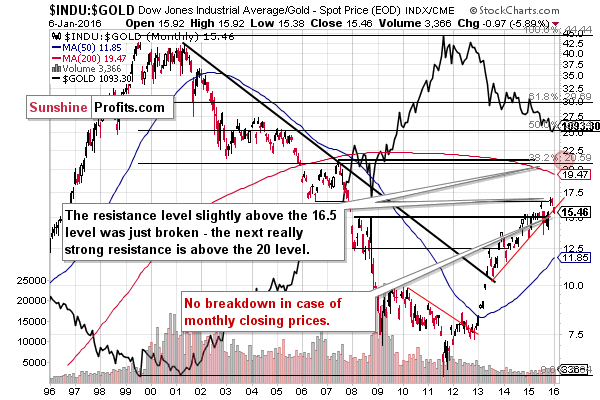
Meanwhile, the Dow to gold ratio moved lower – a bit below the rising support line. The above chart is created using monthly candlesticks, and since January has only just begun, it’s too early to speak of a real breakdown. In fact, previous temporary moves below this support line were reversed and followed by rallies in the ratio (and declines in gold).
Having said that, let’s move to silver.
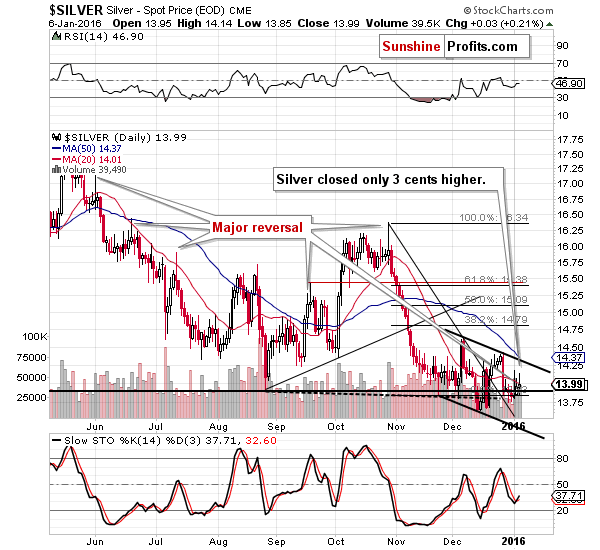
Silver continues not to rally significantly, having “rallied” 3 cents yesterday. With such positive influence from gold, why is silver not rallying? Likely because the trend didn’t change – it is only gold that is reacting due to it’s safe-haven reputation. As you can see, silver is well below the declining resistance line, so even if it moves a bit higher from here, it won’t change anything. For now, silver doesn’t even “want” to close above $14. The implications remain bearish.
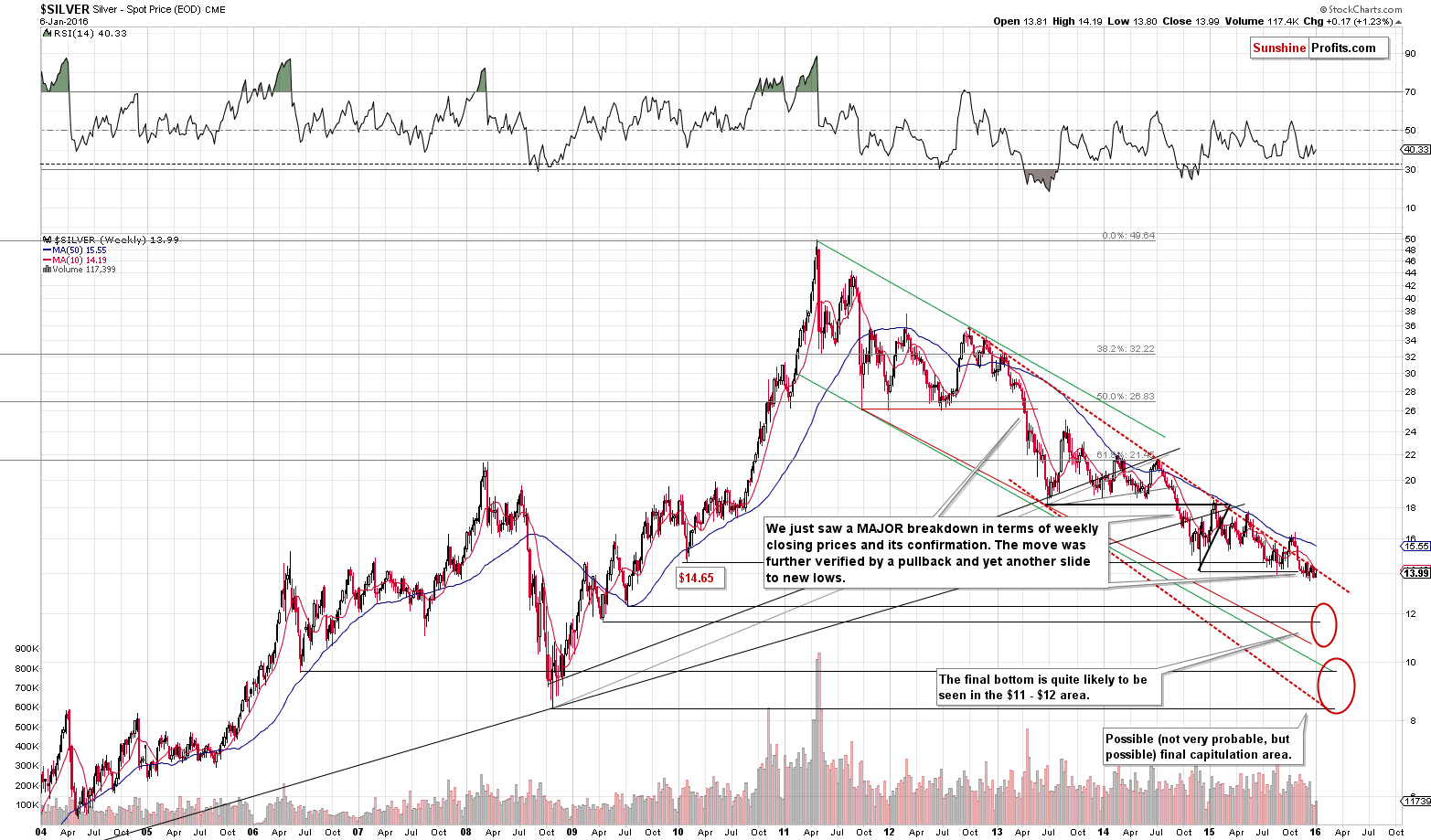
From the long-term perspective nothing changed in the case of silver – the white metals is close to the declining red resistance line, but below it. The implication is that silver is likely to move lower sooner rather than later and that the potential size of the decline is significant.

Moving to gold stocks, the big picture tells us lot. It tells us that more or less nothing happened recently and gold miners continue to consolidate. There was a small move higher this week, but nothing to be excited about.
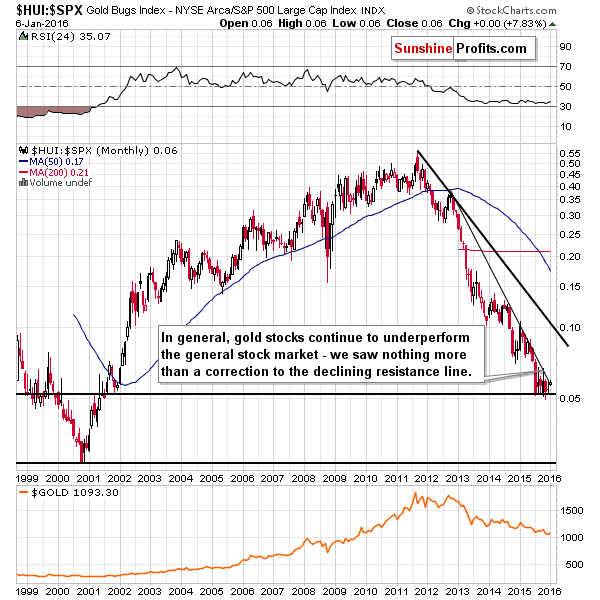
The gold miners’ prices compared to other stocks show that the trend remains down and that gold stocks are likely to move lower relatively soon as the HUI to S&P 500 ratio moved to its declining resistance line.
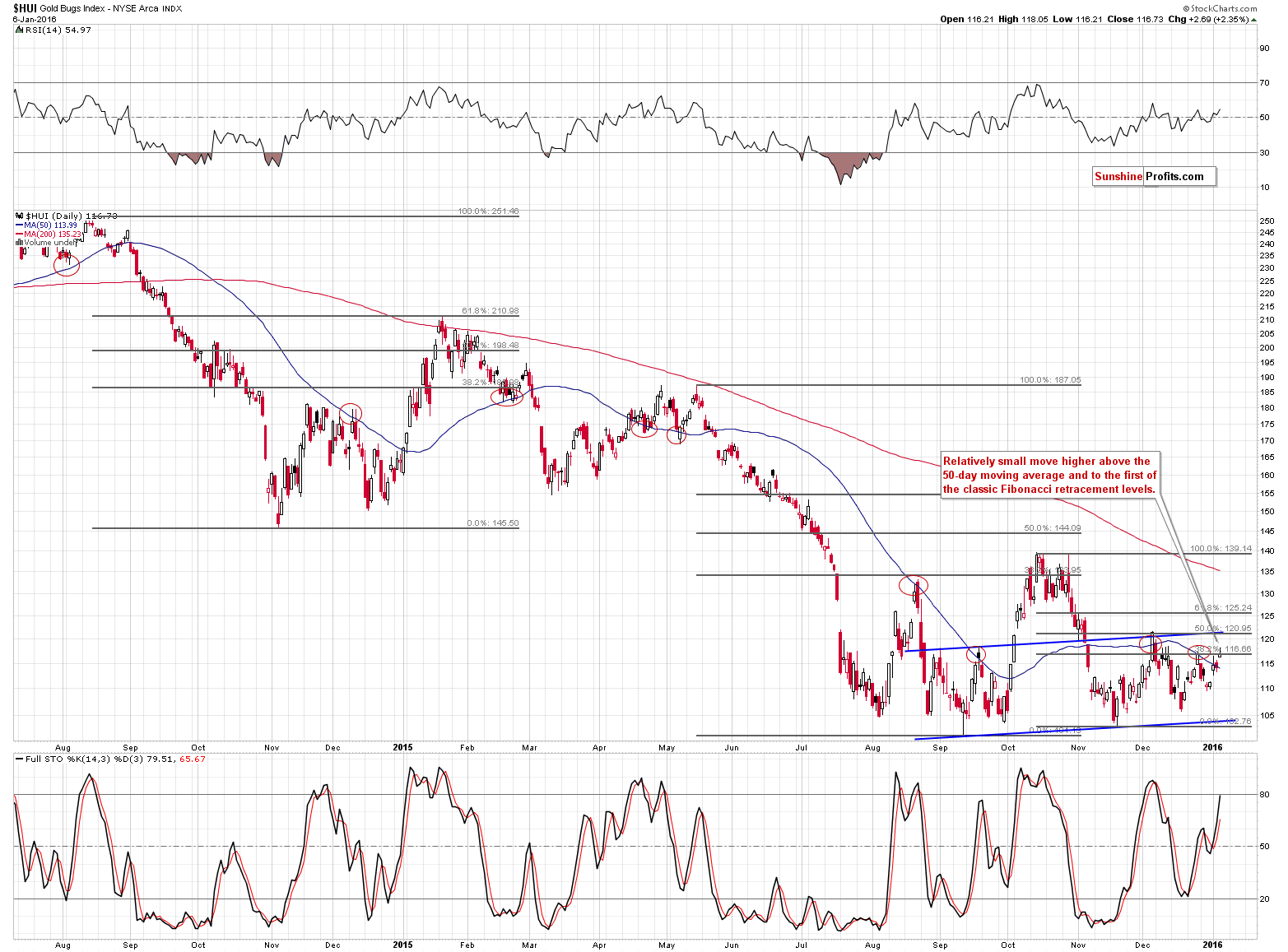
Is the rally in gold stocks something really bullish? Not really – not only is the rally smaller than it is the case with gold (the HUI is not even very close to its December 2015 high, while gold exceeded it), but the HUI is also at the first of the classic Fibonacci retracement levels – there was no major breakout above this line. The breakout above the 50-day moving average is not confirmed at this time, so there are actually little bullish implications of this week’s move higher in mining stocks.
There’s one more factor that we can discuss and these are our internal metrics representing the sentiment among precious metals investors – like the amount of people that sign up for our mailing list, visits on certain pages, the amount of e-mails that we receive and so on. We can say that the recent move higher in gold appears to be very important and it gets investors excited. This is a very important observation because really not much changed in the charts and there is a good explanation for the move higher in gold (and for it being a temporary phenomenon) – its safe-haven reputation. The above combination of sentiment and changes in the charts has bearish implications. Of course, that’s just our opinion and we could be wrong, but in most cases in the past, lower prices followed similar combinations of events.
Summing up, it seems that gold’s next major downswing was delayed a bit due to unforeseen geopolitical events, which seems to be a temporary phenomenon, not something that changes the current declining trend. Consequently, we are moving the stop-loss level for our gold position higher. Again, we don’t think that the recent move higher in gold changed anything as far as the outlook is concerned and thus we are keeping the short position intact as we think that it remains to be justified from the risk/reward point of view. Is adding to the short position justified at this time? We think this is not the case – the position is already full and increasing it further does not seem justified. Let’s keep in mind that too big positions can hurt one even if one correctly – on average – estimates the moves in the market.
Naturally, we would prefer to see gold decline immediately after a position is initiated – just like stocks declined recently right after we opened the short position (Dec. 30, the S&P opened at 2077) and just like crude oil plunged shortly after we opened a short position in it (Dec. 28, crude oil opened at $38) or even like the action in the EUR/USD pair which moved lower a few days after we opened a short position in it (Dec. 23, EUR/USD was at about 1.0944) – but there are some things, like geopolitical events, that can’t be predicted and at times it takes longer for a position to be profitable than it seemed to be the case when the position had been opened. Still, the current short position remains to be justified in our view and it’s likely that it will become profitable in the next several days or weeks.
As always, we will keep you – our subscribers – updated.
To summarize:
Trading capital (our opinion): Short positions (full) in gold, silver and mining stocks are justified from the risk/reward perspective with the following stop-loss orders and initial target price levels:
- Gold: initial target price: $973; stop-loss: $1,143, initial target price for the DGLD ETN: $117.70; stop-loss for the DGLD ETN $74.28
- Silver: initial target price: $12.13; stop-loss: $14.83, initial target price for the DSLV ETN: $101.84; stop-loss for DSLV ETN $57.49
- Mining stocks (price levels for the GDX ETF): initial target price: $10.23; stop-loss: $15.47, initial target price for the DUST ETF: $31.90; stop-loss for the DUST ETF $10.61
In case one wants to bet on junior mining stocks' prices (we do not suggest doing so – we think senior mining stocks are more predictable in the case of short-term trades – if one wants to do it anyway, we provide the details), here are the stop-loss details and initial target prices:
- GDXJ ETF: initial target price: $15.23; stop-loss: $21.13
- JDST ETF: initial target price: $52.99; stop-loss: $21.59
Long-term capital (our opinion): No positions
Insurance capital (our opinion): Full position
Plus, you might want to read why our stop-loss orders are usually relatively far from the current price.
Please note that a full position doesn’t mean using all of the capital for a given trade. You will find details on our thoughts on gold portfolio structuring in the Key Insights section on our website.
As a reminder – “initial target price” means exactly that – an “initial” one, it’s not a price level at which we suggest closing positions. If this becomes the case (like it did in the previous trade) we will refer to these levels as levels of exit orders (exactly as we’ve done previously). Stop-loss levels, however, are naturally not “initial”, but something that, in our opinion, might be entered as an order.
Since it is impossible to synchronize target prices and stop-loss levels for all the ETFs and ETNs with the main markets that we provide these levels for (gold, silver and mining stocks – the GDX ETF), the stop-loss levels and target prices for other ETNs and ETF (among other: UGLD, DGLD, USLV, DSLV, NUGT, DUST, JNUG, JDST) are provided as supplementary, and not as “final”. This means that if a stop-loss or a target level is reached for any of the “additional instruments” (DGLD for instance), but not for the “main instrument” (gold in this case), we will view positions in both gold and DGLD as still open and the stop-loss for DGLD would have to be moved lower. On the other hand, if gold moves to a stop-loss level but DGLD doesn’t, then we will view both positions (in gold and DGLD) as closed. In other words, since it’s not possible to be 100% certain that each related instrument moves to a given level when the underlying instrument does, we can’t provide levels that would be binding. The levels that we do provide are our best estimate of the levels that will correspond to the levels in the underlying assets, but it will be the underlying assets that one will need to focus on regarding the sings pointing to closing a given position or keeping it open. We might adjust the levels in the “additional instruments” without adjusting the levels in the “main instruments”, which will simply mean that we have improved our estimation of these levels, not that we changed our outlook on the markets. We are already working on a tool that would update these levels on a daily basis for the most popular ETFs, ETNs and individual mining stocks.
Our preferred ways to invest in and to trade gold along with the reasoning can be found in the how to buy gold section. Additionally, our preferred ETFs and ETNs can be found in our Gold & Silver ETF Ranking.
As always, we'll keep you - our subscribers - updated should our views on the market change. We will continue to send out Gold & Silver Trading Alerts on each trading day and we will send additional Alerts whenever appropriate.
The trading position presented above is the netted version of positions based on subjective signals (opinion) from your Editor, and the Tools and Indicators.
As a reminder, Gold & Silver Trading Alerts are posted before or on each trading day (we usually post them before the opening bell, but we don't promise doing that each day). If there's anything urgent, we will send you an additional small alert before posting the main one.
=====
Hand-picked precious-metals-related links:
UBS: Give up on stocks this year and buy gold
Kaminak Gold announces positive feasibility
=====
In other news:
George Soros Sees Crisis in Global Markets That Echoes 2008
Asia shares slump as China sets yuan lower, triggers circuit breaker
Oil drops to $32 as fears about China's economy grow
European Stocks Deepen Slump as China Rout Worsens on Yuan Cut
=====
Thank you.
Sincerely,
Przemyslaw Radomski, CFA
Founder, Editor-in-chief
Gold & Silver Trading Alerts
Forex Trading Alerts
Oil Investment Updates
Oil Trading Alerts



